The Art of Communication: Understanding Talking in Pet Birds
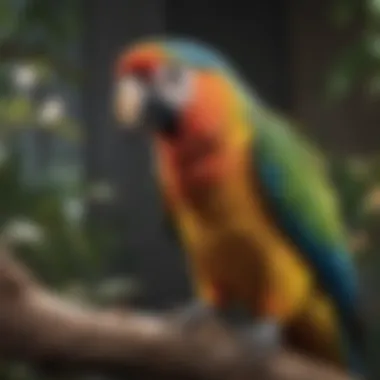
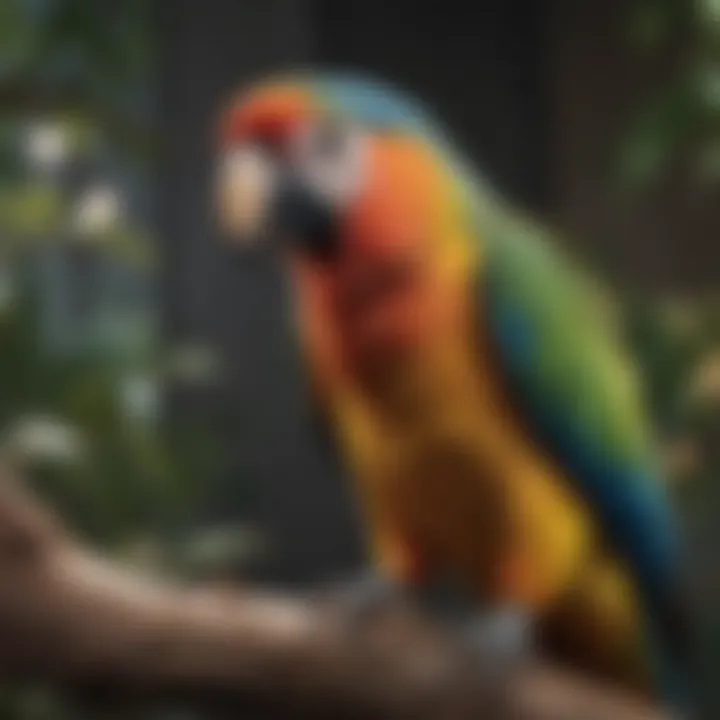
Intro
Understanding the dynamics of communication in pet birds captivates many enthusiasts and owners. Birds, particularly species like the African Grey Parrot or the Canary, possess remarkable vocal capabilities. However, speaking isn't merely a random occurrence; it is a complex behavior influenced by a range of factors. Factors includes species characteristics, environmental considerations, and the level of social interaction among them.
Exploring these elements is essential for every bird owner who seeks not just to hear but also to engage in a meaningful dialogue with their pets. Therefore, this article aims to provide valuable insights into the different aspects of avian communication, encompassing care tips, behavioral nuances, proper diet, health considerations, and enriching activities.
Care Tips
Caring for a talking bird requires more than just feeding and a clean cage. Birds are sensitive creatures with emotional and physical needs. By understanding how to address these, owners can foster environments conducive to both well-being and vocal engagement.
Daily Care Routines
Daily routines set the foundation for healthy communication. Engage with your bird each morning, offering fresh food and water. Birds thrive on consistency. Include short sessions of talking or singing with them daily, as this stimulates both their interest in vocal mimicry and social bonds with the owner.
Cage Setup and Maintenance
The cage should be spacious and equipped to cater to the various needs of the bird. Provide multiple perches, some at varying heights, to encourage physical activity and prevent boredom. Keep the cage clean by regularly replacing bedding and removing waste, as cleanliness influences a bird’s health and mood.
Hygiene and Cleaning Practices
Healthy birds are happy birds. Routine cleaning of the cage, food dishes, and toys is crucial. Use safe chemicals; avoid strong fragrances. Every week you should also change the nesting material, ensuring birds are always in a hygienic environment.
Seasonal Care Adjustments
Changes in seasons may need different approaches in care. In winter, for instance, ensure that birds are warm enough, adjusting the environment as needed. In summer, provide shaded areas to prevent overheating. Seasonal changes can influence a birds vocalization and behavior, so owners should remain observant during these times.
Behavioral Insights
Diving into how pet birds interact can offer helpful guidance for enhancing communication.
Understanding Bird Body Language
Observing body language is vital for understanding your bird's emotional state and intentions. Look for subtle cues such as puffing up feathers or vocalizing during certain moments. These actions are indicators that help decode their needs and interests.
Common Behavioral Issues and Solutions
Certain behavioral challenges, such as biting or excessive loudness, may range from need for attention to environmental stressors. Identifying the root cause is central in administering successful interventions. Provide ample activities and attention to minimize negative behaviors.
Positive Reinforcement Techniques
Positive reinforcement, like rewarding with treats or praise, works tremendously well in encouraging the behavior you wish to see. Birds adapt quickly and enjoy routine, making them receptive to consistent training responses.
Social Interaction Needs
Birds, like humans, require interaction. Divide playtime between owner engagement and socializing with other birds, when possible. Insufficient social interactions could lead to distress, sometimes hindering their ability to mimic speech successfully.
Nutrition Guides
A well-balanced diet plays a fundamental role in the physical and mental effectiveness of a bird.
Essential Diet Components
Regarding diet, ensure intake consisting of seeds, pellets, vegetables, and occasional fruits. Each bird species might need a different formula prominent to its unique biology.
Safe and Toxic Foods
While many human foods are safe, some are harmful. Typical poisonous items include avocado and chocolate. Understanding what is safe and what is not could be a difference in maintaining a healthy pet.
Supplements and Treats
Consider employing vitamin supplements only if they are necessary. Increasing natural foraging behavior enhances well-being, so use appropriate treats sparingly.
Feeding Strategies for Different Species
As diets may ravaiably depending on species, research is advisable. Amazons, Macaws, and Finches have variable dietary needs their own. Understanding their specific needs enrich the chances of developing a strong communicative bond.
Wellness and Health
Keeping birds physically and mentally healthy ensures a better chance for them to mimic human speech successfully.
Routine Health Checkups
Regular visits to the avian vet may assist in catching health issues early. Preventive health care builds a foundation for a strong long-term owner-bird relationship.
Identifying Symptoms of Illness
Birds may mask illness until it becomes severe. Look for changes in behavior, appetite, or vocalization patterns. Early detection improves actions taken by owners.
Preventative Care and Vaccinations
Maintenance of vaccines could prevent many fatal diseases. Educate yourself on the necessary vaccines for your type of bird to safeguard its health.
Mental and Emotional Well-being
Correlate stressors or absences with changes in their vocal habits, as emotional states greatly influence their communication. Investing time into providing a stable environment has substantial long-term payoff.
Enriching Activities

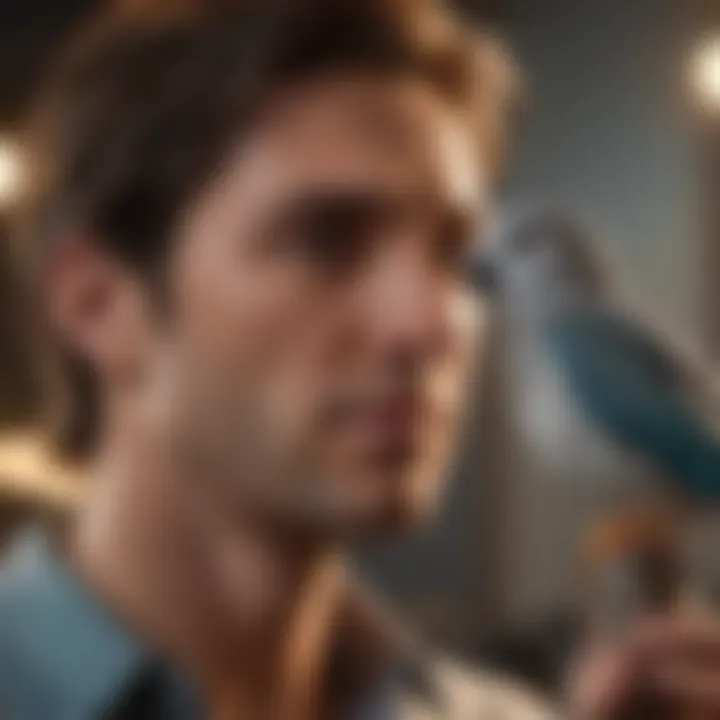
Ultimately, stimulating a bird mentally affects its communicative proficiency.
Toys and Playtime Ideas
To remain lively and maintain engagement, incorporate a variety of toys. Rotate them regularly to spark interest. Lure them to play instead of allowing them to grow accustomed of solitude and boredom.
Training and Tricks
Introduce small training sessions, teaching simple words or tricks. Bird prefer learn through imitation, allowing birds flexibility in them their vocal range.
Outdoor Activities and Interaction
Ensure outside playtime while being secured in a suitable harness. Diverse environments enrich their exposure and promote vocal experimentation.
DIY Projects for Mental Stimulation
Consider creating interactive toys from household items. These serve dual roles as enrichments of interaction while also exercising mental prowess.
These care tips reflect a holistic method towards nurturing the ability to communicate, meriting attention in various forms for an owner-bird enriching relationship.
The subsequent sections will further elaborate on additional aspects of understanding pet bird communication, aiming toward profound engagement and enrichment for both the avian companion and its owner.
Prolusion to Bird Communication
Effective communication is essential in establishing a bond with pet birds. Understanding how birds communicate is crucial for pet owners, as it significantly impacts interaction and care. Discussing bird communication allows us to gain insight into their vocalizations, enabling better engagement with these avian companions.
Birds use multiple vocalizations to express their feelings, warn of danger, or call for mates. An owner who grasps this verbal language enhances the pet’s well-being. These sounds often signal their needs, emotions, and health states. For instance, a chirp of joy or a loud squawk might reflect contentment vs. distress, respectively.
Fostering a richer communication experience is not just beneficial for the bird, but it enhances the owner's understanding of behaviors, strengthening the human-bird relationship. Moreover, recognizing these subtle signs assists in maintaining a favorable living environment, improving the quality of life for both parties.
In addition to vocalizations, non-verbal signals play a significant role in bird interactions. Body language, such as wing flapping and head tilting, also deserves acknowledgement. Awareness of these can help reduce misunderstandings and anxiety.
This section aims to unravel the nuances of bird communication, equipping owners with the tools to build stronger connections. Ultimately, a clear understanding of avian communication not only supports the emotional and mental health of pet birds but elevates the entire experience of bird ownership.
Understanding Avian Vocalization
Avian vocalization is not just a remarkable feature of birds; it serves several crucial functions within their lives and interactions. Understanding how pet birds communicate through vocalization is important for owners and enthusiasts alike. It sheds light on their emotional states, needs, and social bonds. This knowledge helps owners create a deeper connection with their feathered companions. Understanding vocalization also guides the proper setting for training their pets, as daily routines can influence how birds vocalize.
Physical Mechanisms of Sound Production
Birds produce sounds through an organ called the syrinx, located at the junction of their trachea and bronchi. Unlike humans who use vocal cords in the larynx, the syrinx allows birds to create a variety of pitches and tones with great efficiency and control. This dual-chamber structure generates complex sounds, making their vocalizations unique even among different species. The airflow created by the muscles surrounding the syrinx can adjust the pitch and volume, adding to their vocal diversity. Factors such as body size, species-specific anatomy, and the surrounding environment can also affect a bird's sound production.
Important Considerations
- Air Sac Pressure: Birds modulate their sounds by changing the pressure in the air sacs connected to the syrinx.
- Muscle Control: The intricate control of muscles involved in sound production influences a bird's ability to mimic sounds, resulting in a range of vocal expressions, from cries to intricate phrase imitation.
Understanding these mechanics provides a foundational knowledge for enhancing speech practices in talking birds, lifting their vocal abilities to a remarkable level.
Natural Vocalizations and Their Functions
Natural vocalizations in birds serve several primary functions: attracting mates, establishing territory, and communicating with other members of their species. Specific calls may signal alertness or danger. Moreover, certain species develop unique patterns influenced by their surroundings. Here are several key roles that vocalizations play:
- Mating Calls: Birds often use varying sounds to display their fitness to prospective mates.
- Alarm Calls: Besides home-sweet-home, birds convey threats to others using distinctive alarm signals, helping their flocks stay alert.
- Territorial Calls: Calls indicate boundaries, asserting dominance over an area; this helps minimize conflicts with other individuals.
The different vocalizations showcase not only the song but also the category and quality of their calls, painting an intricate picture of a bird's life. Observing these behaviors reveals how well-adapted birds are to their environments. The nuances in their communicating patterns can help pet bird owners replicate aspects of their natural vocalization to enhance mimicking skills and emotional welfare.
In summary, avian vocalization encompasses a diverse range of physical techniques and natural functions vital to bird communication, reflecting both their individuality and innate social tendencies.
Bird Species Prone to Talking
Understanding the specific bird species known for their vocal abilities is crucial for pet owners who aspire to have a talking bird. Each species exhibits unique traits that make them inclined to mimic human speech and sounds. By knowing which birds are natural talkers, one can select a companion that aligns with their expectations and living situation.
Parrots: The Chattiest of All
Parrots are often regarded as the champions of avian communication. Their ability to mimic not just human voices but also environmental sounds is phenomenal. These birds possess a high level of intelligence and social awareness. These traits allow them to learn and replicate speech more effectively than other birds.
Training parrots can be rewarding, as they often engage in chatty behaviors. The gray parrot, for instance, is known for its impressive vocabulary, sometimes comprising hundreds of words. This makes parrots an exceptional choice for an owner seeking an interactive and responsive pet.
Other Notable Talking Birds
While parrots often steal the limelight, other species also deserve mention for their talking ability.
Canaries
Canaries are frequently celebrated for their melodic singing rather than talking. While they can mimic some sounds, their primary attraction in the realm of avian companionship lies in their songs. A distinctive characteristic of canaries is their musical talent. This makes them suitable for those looking maybe less for dialogue and more for song in the home.
However, their talking ability is limited compared to more vocal species. For those who appreciate sound but do not necessarily seek a conversationalist, canaries are a sound choice.
Budgerigars
Budgerigars, commonly called budgies or parakeets, rank high on the talking ability list. This small parrot species has proven to be an excellent option for first-time bird owners. A key advantage of budgerigars is their social nature, which facilitates vocal learning. They can hold conversations and even master their names is something many find appealing.
Despite their capabilities, budgies can have moments of chattiness as sporadic as it is when compared to larger parrots. Nevertheless, their charm and starter-friendly traits solidify their popularity as talking pets.
Macaws
Macaws are among the larger birds, notable both for their colorful plumage and significant vocal ability. They possess strong personalities and can develop a substantial repertoire of words and sounds. A decided advantage of macaws is their long lifespans. Once one form a deep bond with an owner, this can lead to conversations and interactions lasting for decades.
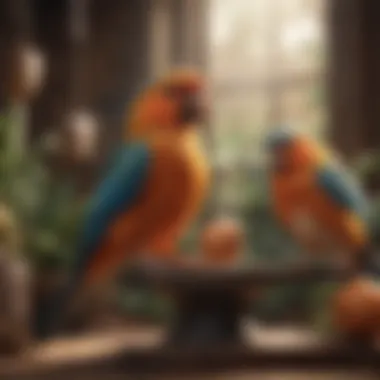

Despite the charm, macaws have specific care requirements due to their size and intelligence. Owning a macaw demands dedication and responsibility. However, for those who commit, the rewards can be truly enriching.
Birds vary immensely in their capacity for communication, and understanding these characteristics is key to creating a fulfilling bird ownership experience.
Factors Affecting Talking Ability
Understanding the various factors that affect talking ability in pet birds is crucial in enhancing their ability to mimic human speech. Each aspect intertwines in shaping a bird's vocal capabilities. By examining genetic predispositions, environmental influences, and social interactions, pet owners can optimize training approaches and create conducive habitats for vocal development.
Genetic Predispositions
Genetic factors play a significant role in determining a bird's potential to imitate human speech. Certain species have an innate ability to mimic sounds. For instance, African Greys and Amazon Parrots are often recognized for their extensive vocabulary and clarity of mimicry.
The genetic characteristics influencing vocalization tend to be more remarkable in these species. The anatomy of their vocal organs, like the syrinx, is uniquely adapted for producing complex sounds. Consequently, selecting the right breed can be a foundational step for those seeking chatty companions. Identifying if a bird has good lineage and understanding its genetic background is crucial for potential owners.
Environmental Influences
The surrounding environment significantly impacts a pet bird's aptitude for talking. Birds thrive in stimulating settings filled with physical and sensory enhancements. Their habitat should reflect their active nature, providing safe toys, perches, and climbing opportunities that promote exploration
As the bird interacts with stimuli in its environment, it becomes familiar with different sounds and tones. Engaging spaces can facilitate curiosity, pushing birds to vocalize more frequently. Background human conversations and music can positively drive this behavior while encouraging repetition and reinforcement.
Training Techniques for Encouraging Speech
Training techniques play a vital role in enhancing the speech abilities of pet birds. These methods are necessary for maximizing not just the vocalization skills but also the overall relationship between birds and their owners. By understanding how to effectively engage with their feathered companions, owners can create an environment conducive to learning and vocal development.
Establishing a Foundation for Learning
Establishing a solid foundation for learning is the first step in training pet birds to talk. This process includes creating a safe and calm environment. A valuable aspect is to ensure that the bird feels secure. Without this sense of safety, progress in learning can be hindered. Owners should also take the time to build trust. Connecting through interaction helps lay the groundwork for effective communication.
Utilizing familiar phrases and consistent language patterns makes it easier for birds to grasp speech. It's significant to choose select words or phrases that will be useful in everyday communication. Sounds made during feeding or play could often be repeated to encourage birds to respond back formatively.
Using Positive Reinforcement
Positive reinforcement is a powerful tool in training birds. It can accelerate their learning process. Rewarding birds when they attempt to mimic speech reinforces the behavior as positive. Using treats or verbal praise can apply strong motivation, helping birds associate talking with rewards. This makes them more inclined to vocalize.
It's important to regulate the timing of rewards—provide reinforcement immediately after the desired behavior. If an owner waits longer, the connection between the action and the reward may weaken. Consistency in this practice builds familiarity and encourages a stronger response.
The key benefits of positive reinforcement in bird training include:
- Instilling confidence in vocal attempts.
- Encouraging continuation of speech practice.
- Developing a clear bond between pet and owner.
Repetition and Contextual Learning
Repetition is essential in helping pet birds learn speech. Birds are naturally capable of mimicking sounds they frequently hear. This makes repeating specific words or phrases effective. Training sessions should include balance between repetition and varied context. Introducing words in different situations makes learning valid and relatable.
Contextual learning thrives on relevant interaction; for instance, saying
Creating a Stimulating Environment
Creating a stimulating environment is vital for enhancing the communication skills of pet birds. The right setting can significantly influence a bird's ability and willingness to vocalize. Birds, being social creatures, require an environment that encourages interaction and mental engagement. Physical and social dynamics play a crucial role in their development and enhancement of vocal abilities.
Physical Enrichment for Vocal Development
Physical enrichment is one key aspect that contributes to vocal development in birds. This creation of a stimulating environment involves various factors such as:
- Varied Enrichment Items Providing diverse toys serves multiple functions. Toys that require manipulation not only fend off boredom but also inspire vocalization.
- Climbing Structures Birds that engage in climbing can explore and exhibit natural behaviors that stimulate their vocal instincts. Perches of different heights and materials allow them to feel secure and encourage them to communicate more.
- Nature Sounds
Incorporating natural sounds, such as recordings of other birds, can stimulate vocalization. Keeping a peace of nature with a small water feature mimics an outdoor setting that birds may find inviting.
The importance of these elements is clear. An enriched space not only breaks monotony but promotes natural behaviors that underline vocal expression.
Social Dynamics Within the Home
The social structure in the home profoundly impacts a bird's communication. Birds inherently thrive on interaction, which directly aligns with their instinctual drive to vocalize.
- Interactive Sessions Dedicating time to speak and interact with a bird can provide crucial reinforcement for vocal expression. Birds that feel secure and engaged are more likely to mimic human speech.
- Household Dynamics
The interactions among household members influence the bird's communication landscape. Socializing with different people can lead to a diverse range of sounds and mimicry, as birds often pick up on varied tones of voice. - Positive Human-Bird Relationships Establishing a bond built upon trust encourages birds to express themselves through vocalization. The reciprocation of sounds from human to bird fosters an atmosphere of enthusiasm about vocalizing.
The Psychological Aspect of Bird Communication
Understanding the psychological elements in avian communication is crucial in grasping how pet birds interact with their environment and their owners. It acknowledges the complex nature of these animals, influences their vocal abilities and enriches the relationship between birds and humans. Recognizing how a bird's mind works enables better communication and fosters overall well-being. The mental aspects of bird communication affect how effectively they mimic speech, how they express emotions, and how they relate with their humans. In this section, we delve into these intricacies to enhance your understanding of avian speech and the bonds formed through it.
Understanding the Bird's Perspective
To train a bird correctly, one must first grasp the mindset of the bird. Birds are highly intelligent creatures, possessing a cognitive ability that rivals that of some mammals. Understanding their perspective derives benefits such as facilitating communication, enhancing training compliance, and recognizing signs of stress or comfort.
Firstly, a bird needs its environment to feel safe and secure, making it more likely to mimic the sounds it hears. If the atmosphere is filled with stress or confusion, vocal mimicry becomes hindered. Observing nuances in behavior, such as how a bird reacts to different tones of voice and sounds, provides insight into its feelings. An owner who understands this can craft varied interactions that entice their bird’s curiosity, leading to vocal exploration. Factors including time of day, noise levels, and social presence all influence a bird’s readiness to communicate. By perceiving these elements from the bird's angle, one can understand when the pet is most likely to vocalize or remain silent.
Moreover, using mental stimulation through play and puzzles can engage a bird's mind. Toys that encourage exploration or allow manipulation offer more chances for interactive communication. These activities foster a deeper understanding of the bird's world, contributing positively to its development and speech abilities.
Emotional Bonds and Vocalization
The fostering of emotional bonds between a bird and its owner is instrumental in creating effective communication. Birds, like many pets, can form close attachments with humans. These connections often influence how vocal a bird is, as emotionally secure birds are more inclined to express themselves through speech. Each time an owner interacts with their bird, be it through talking, singing, or playing, it serves to fortify this bond.
Once a bird establishes trust, it becomes more willing to vocalize and mimic. Words and phrases tied to positive reinforcement flourish in this atmosphere built on love and care. When a bird relates specific vocalizations to food or companionship, it is encouraged to repeat them to maintain that connection. The nuances in a bird’s vocal pattern can communicate its emotional state, making this outpouring of vocalization a means of deepening the relationship.
To best promote this form of expression, patience is key. Owners should provide consistent, positive interactions while resisting the urge to rush progress. A deep empathy for the bird’s emotional state not only fosters confidence but cumulatively enhances the quality of vocalizations.
Challenges in Training Talking Birds
Training birds to talk involves distinct difficulties that both seasoned and novice pet owners must navigate. Each species possesses unique characteristics; some are naturally predisposed to vocal mimicry, while others may be more challenging. Understanding these challenges is essential for owners aiming to develop effective communication with their feathered companions. Insights gained through proper training can significantly enhance the bond between owner and bird, creating an enriching experience for both parties.
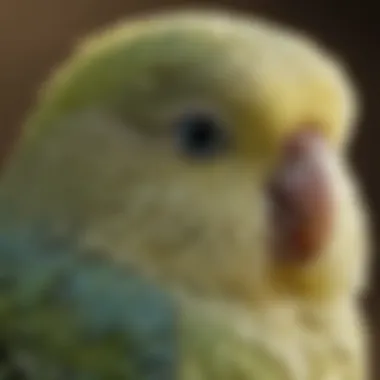
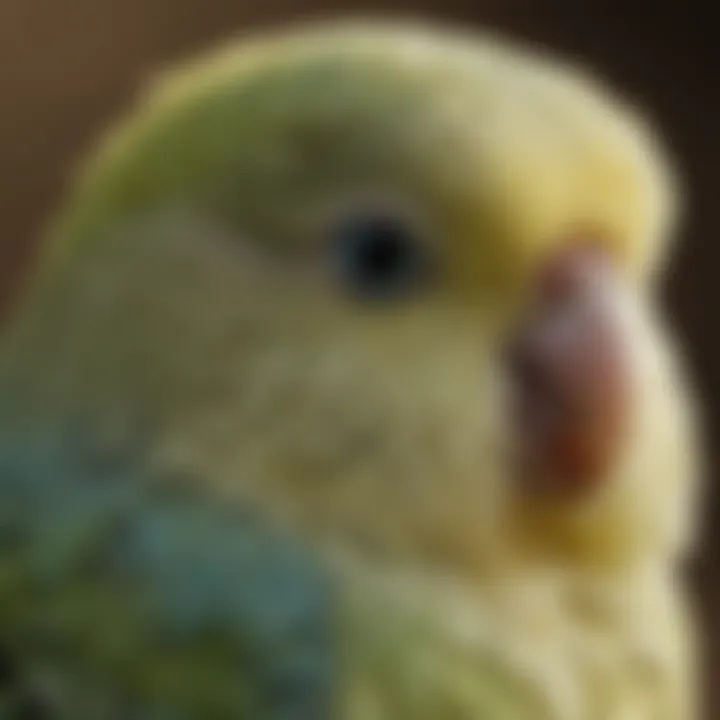
Common Misconceptions About Talking Birds
Many misconceptions exist related to speaking birds. For instance, some may believe that all species can easily learn to talk. However, this is not the case. Certain species like African Grey Parrots or Amazon Parrots excel in vocal mimicry, whereas others, such as Cockatiels, may struggle. Not understanding this can lead to frustration for owners and can diminish the time spent with the bird.
Another common misconception is that any bird, regardless of age, can quickly learn to talk. While younger birds often learn more readily, older birds can also learn but tend to require more patience and consistent training over a longer duration. Failing to acknowledge this can create unrealistic expectations.
It is also incorrect to assume that once a bird learns to speak, it will continuously do so. Like humans, birds possess different personalities. Some may choose to vocalize frequently, while others may display limited preferences, mimicking sparsely.
Addressing Behavioral Issues
Addressing behavioral issues plays a crucial role in enhancing a bird's communication skills. Birds are sensitive creatures. Problems such as screaming, biting, or refusing to interact can hinder vocalization efforts. In many cases, difference in environment cause stress which may lead to undesirable behaviors. An approach to moderation is necessary, ensuring their surroundings remain calm, consistent, and rich in stimulation.
Multiple techniques can assist much in overcoming these challenges. Firstly, understanding body language is very important. Therefar, recognizing signs of discomfort or anxiety allows owners to adjust the atmosphere. Additionally, establishing a reliable routine can offer a sense of stability for birds, further reducing stress-related behaviors.
Incremental training, where bird owners break down instructions into simple, manageable tasks can foster an environment where the birds feel respected, leading to better outcomes in vocalization attempts. Behavioral issues often linger heavily linked to the overall human-animal relationship. Focus here is vital; positively reinforcing good behavior results as essential, not just interruptions of negative behavior cues.
Influencing motivation is another effective way, as happy birds are more likely to vocalize. Engaging playtime, fresh sights, and sounds can greatly influence vocal abilities.
The nucleus of overcoming these challenges lies in patience and understanding, both of which lead dynamic relationship with the bird, which is paramount.
Recognizing and Celebrating Success
Recognizing and celebrating success in the context of talking pet birds is a key aspect for both owners and birds. It fosters an environment where progress is acknowledged, encouraging further development of vocal skills. Birds can thrive when they sense that their efforts have meaning and that their attempts at communication are valued.
Marking achievements, no matter how small, informs the bird that they are on the right track. Success can range from a single new word to more extended phrases. This encourages the bird to push out of their comfort zone and experiment with new sounds and vocal patterns.
Moreover, recognizing milestones can enhance the bond between the bird and its owner. This creates a shared experience that solidifies trust and communication. Owners should actively look for positive behaviors or vocalizations to applaud, reinforcing the message that the efforts made are appreciated.
Documenting Progress
Documenting the progress of a talking bird serves several essential purposes. Firstly, it offers an essential perspective on development over time. Keeping track of new words learned, behavioral improvements, and overall vocalization growth can be very motivating. This practice provides a timeline to visualize how much the bird has advanced.
To effectively document progress:
- Create a journal: Regular entries after training sessions can help highlight what was achieved.
- Video recordings: Capture vocalizations to show transformation, keeping a visual evidence helps to understand progress better.
- Set specific goals: Identify targeted words or phrases, and track their acquisition.
This meticulous attention to detail not only provides records but also becomes a focal point for discussions with other pet bird owners or trainers, which can stimulate more conversational interactions.
Using Conversations to Connect
Engaging in conversations with one's pet bird is a unique experience that allows a much deeper connection. It goes beyond verbal communication, allowing for emotional bonding through shared moments. Birds often learn to imitate the tone, rhythm, and even the emotion in a voice, adapting their skills based on their interaction with humans.
Some effective ways to use conversations intentionally include:
- Consistent Dialogue: Engaging regularly in language-rich dialogues helps the bird in language recognition.
- Repetition: Ask key phrases or questions during everyday activities, which reinforces learning.
- Encouragement: Responding positively when the bird attempts to speak fosters more attempts at conversation, reinforcing their efforts.
Ethical Considerations in Bird Communication
Understanding the ethical considerations in bird communication is fundamental for pet bird owners and breeders alike. This topic involves reflecting on the natural behaviors of birds and promoting a respectful relationship between birds and humans. Although training birds to talk can be an immensely rewarding experience, it must be approached with thoughtfulness and care.
Understanding Natural Behaviors
Birds in their natural habitats exhibit behaviors meant for survival, reproduction, and social interaction. These natural behaviors often involve vocalizations that serve various functions. It is crucial to recognize that captivity can alter these behaviors. Keeping a bird solely for its ability to mimic speech can overlook its needs as a sentient being, which can lead to distress and behavioral issues.
Bird owners should aim to understand the natural within their chosen species. For example, parrots typically live in complex social groups in the wild. By emulating a social and stimulating environment at home, owners promote more genuine communication. If a bird doesn't demonstrate talking abilities, it can still vocalize in other meaningful ways, such as calling out or chattering.
Additionally, becoming informed about species-specific behaviors can help owners appreciate the depth of their pet's communication skills beyond mere mimicry. Training should not overshadow or suppress any natural form of vocalization.
Promoting Healthy Interactions
Healthy interactions are key for a bird's psychological well-being and social development. Bird owners must provide environments that allow for interactions that are enriching rather than coercive. This involves nurturing their instincts and speaking to them in a way that promotes trust. Contributions to mental well-being often mean allowing birds to speak when they desire rather than forcing them to mimic sounds or words.
Additionally, interaction should be varied. Use of diverse vocal cues, and engaging through games or toys can facilitate communication without merely focusing on teachable phrases. Important strategies include:
- Developing a bond of trust through gentle daily routines.
- Observing and responding to a bird’s mood and vocalization tendencies.
- Providing new learning opportunities that involve collaboration.
Creating a conversation relies not only on teaching birds but also inviting them to participate as active communicators. Their natural tendencies communications should be welcomed and nurtured for a better relationship.
Hatching a conversation with your bird enhances its emotional intelligence and can lead to richer bonds.
In summary, ethically responsible bird ownership means honoring their natural instincts and fostering healthy relationships. Recognizing their right to express themselves freely supports both the bird's happiness and the human-animal interaction.
The End: The Impact of Communication on Bird Ownership
In the relationship between avian pets and their owners, communication snakes through every aspect, shaping behaviors, interactions, and emotional connections. Understanding how pet birds communicate, especially through talking, enhances not just the bird’s experience but also graces owners with deeper bonds with their feathered companions. Talking is more than mere mimicry; it is a vital part of a bird's social skill set that reflects their environment and personality.
The ability of a bird to mimic human speech can strengthen the connection between the bird and its owner, fostering trust and affection. This interaction is reciprocal, as owners often respond to the bird's vocalizations, further creating a context for meaningful exchanges. Moreover, effective avian communication influences overall behavior, making the bird feel more secure and engaged within its domain.
Benefits of Enhanced Communication
Improved communication distinguishes bird ownership in several essential aspects:
- Enriched interaction: Birds, like African Grey Parrots and Sun Conures, thrive on the interaction they get with their owners. Engaging in vocal exchanges elevates the experienced delight in both parties.
- Behavioral understanding: Birds vocalize emotions such as joy, sadness, and anxiety. Owners possible to detect changes in vocal behavior may be used to address needs or behavioral shifts.
- Strengthened emotional bonds: Communication beyond food and care fosters emotional responses and trust. Speaking cues bring the experience of companionship to new heights.
Considerations in Communication Practices
However, expectations must stay realistic. Not every bird will reach the same level of communicative prowess. Training requires patient consistency. Addressing this through supportive engagement, without the zeal to force results, concludes that it mirrors an effort to foster an environment of love instead of stress.
Additionally, owners should be cautious to refrain from forgive improper or unwanted vocalizations. Removing an audience could inadvertently suppress communication attempts Liby instead of encouraging the interaction. This complexity mimics human relationships where understanding sustains connections.
Maintaining a rich environment likely feeds into providing opportunities for interaction and trining. A stimulating background, alongside nurturing and curious engagement, confiscate abounding positive impacts on development.
“In understanding avian vocal patterns, we clutch not just the responsibility as caretakers, but a shared dialog with our birds, bridging species through simple forms of expression.”
As the last impression in our exploration of talking birds, the insight regarding their communicative behaviors functions not haphazardly. This conclusion encapsulates the value of informed bird ownership, influencing multiple dimensions of care and companionship. Owners embracing this understanding create responsive environments where simplicity flourishes and connections thrive, leading to gratifying companionship that goes beyond mere observation.















